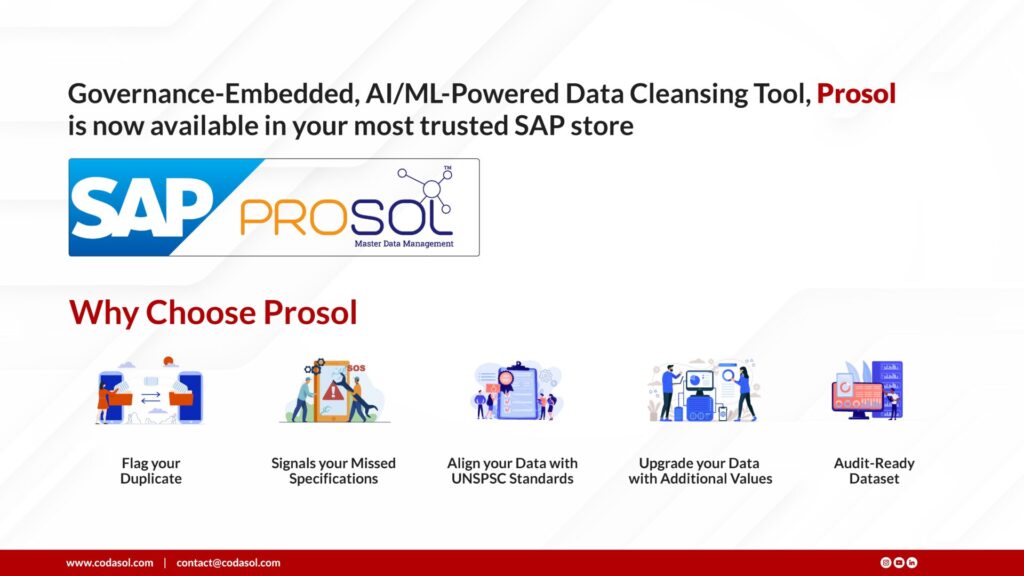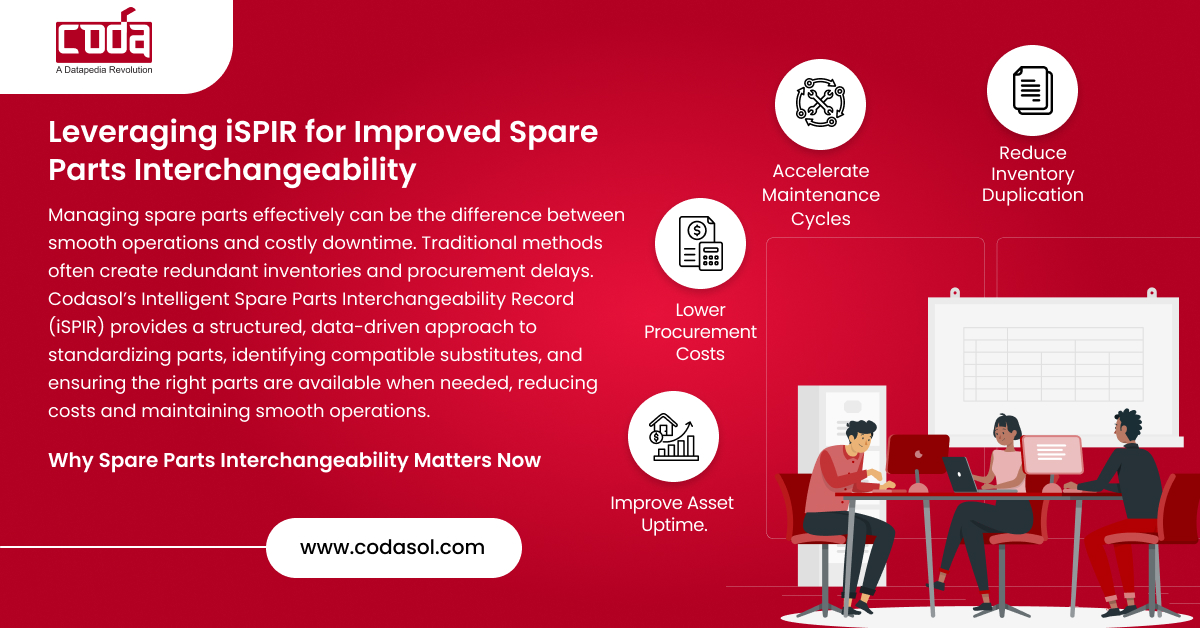Leveraging iSPIR for Improved Spare Parts Interchangeability
In asset-intensive industries, downtime isn’t just inconvenient; it’s expensive. Every hour of equipment failure can cost thousands, sometimes millions, in lost production. Yet, many organizations unknowingly tie up capital in redundant, incompatible spare parts that sit idle. The culprit? A lack of spare parts interchangeability.
iSPIR, the Intelligent Spare Parts Interchangeability Record, a structured, data-driven framework designed to eliminate redundancy, standardize parts, and ensure seamless compatibility across plants and assets.
This isn’t just about better inventory management; it’s about operational resilience, cost control, and data-driven decision-making.
What Is Spare Parts Interchangeability?
At its core, spare parts interchangeability is the ability to substitute one part for another without compromising performance, safety, or compliance. It’s a critical principle in maintenance, repair, and operations (MRO), especially in industries where identical components are used across multiple assets or facilities.
Traditional SPIRs (Spare Parts Interchangeability Records) were static forms submitted by OEMs (Original Equipment Manufacturers) during project handovers. They identified which parts could replace or substitute one another. However, most organizations struggled to operationalize this data due to inconsistencies in format, missing attributes, and poor integration with enterprise systems.
iSPIR, the intelligent evolution of SPIR, bridges that gap. It digitizes and standardizes spare part data, integrates directly with ERPs and MDM systems, and enables real-time decision-making across engineering, procurement, and maintenance.
Why Spare Parts Interchangeability Matters Now
Today’s industrial landscape is defined by rising costs, unpredictable supply chains, and aging infrastructure. Companies can’t afford delays in sourcing or unplanned downtime.
Adopting an iSPIR-driven approach to spare parts interchangeability enables organizations to:
- Reduce inventory duplication: Identify and merge identical or compatible parts across plants.
- Accelerate maintenance cycles: Quickly locate suitable substitutes when OEM parts are unavailable.
- Lower procurement costs: Rationalize vendor bases and negotiate better terms through consolidated demand.
- Improve asset uptime: Ensure maintenance teams have access to compatible spares, reducing Mean Time to Repair (MTTR).
- Enable predictive maintenance: Support AI-driven forecasting models that anticipate failures and recommend alternatives.
According to a Deloitte study, companies that standardize MRO master data can cut procurement costs by 10–15% and improve uptime by up to 20%.
The Technology Backbone: MDM and Data Governance
Spare parts interchangeability can’t exist without reliable, structured data. That’s where Master Data Management (MDM) comes in.
An MDM-enabled iSPIR environment ensures that every spare part across your organization follows consistent definitions, attributes, and classifications. Key data points often include:
- OEM part number and manufacturer
- Material, dimensions, and tolerance limits
- Functional description and fitment data
- Form-Fit-Function (FFF) equivalence
- Lifecycle status (active, obsolete, superseded)
Integration with enterprise platforms like SAP, Oracle, or Maximo allows maintenance teams to automatically cross-reference compatible parts and avoid duplicate entries during creation.
| Aspect | Without MDM | With MDM-Enabled Interchangeability |
|---|---|---|
| Data consistency | Manual, error-prone | Standardized and governed |
| Duplicate entries | High | Automatically prevented |
| Supplier visibility | Fragmented | Unified and transparent |
| Decision-making | Reactive | Predictive and proactive |
How to Implement Spare Parts Interchangeability: A Step-by-Step Roadmap
For organizations serious about optimization, here’s a practical roadmap to deploy iSPIR successfully:
- Data Audit: Begin with a detailed review of existing MRO, BOM, and SPIR data. Identify duplicates and missing attributes.
- Data Cleansing: Standardize material descriptions, attributes, and part specifications.
- Define Equivalence Logic: Establish interchangeability rules — e.g., dimensional tolerance, performance equivalence, and OEM-approved substitutes.
- Integration: Configure interchangeability logic within your ERP or MDM system to automate recognition of alternate parts.
- Pilot Program: Start small — focus on one critical asset class or plant to measure improvements.
- Scale Enterprise-Wide: Extend to all business units once accuracy and savings are validated.
- Continuous Governance: Review interchangeability data periodically and apply feedback loops from maintenance and procurement teams.
Common Pitfalls to Avoid
- Inconsistent vendor or OEM data formats
- Lack of stakeholder alignment between engineering and procurement
- Neglecting validation and version control in SPIR updates
Organizations that address these early see faster ROI and smoother change management.

Ready to identify redundant spares in your inventory?
When Data Becomes ROI
Consider a hypothetical example from a refinery in the GCC region. The maintenance team identified that 25% of their stored bearings were duplicates of existing parts, differing only in supplier or minor dimensional variations.
After implementing iSPIR and cleaning their master data, the refinery achieved:
- 23% inventory reduction (≈ USD 2.5 million freed capital)
- 15% faster maintenance response through substitution logic
- 12% savings in procurement from vendor consolidation
- Payback period: under 10 months
These results demonstrate the tangible business case for spare parts interchangeability, a digital transformation initiative that delivers both operational efficiency and financial return.
Traditional vs. Interchangeability-Driven Spare Management
| Parameter | Traditional Spare Parts | Interchangeability-Driven Approach |
|---|---|---|
| Inventory Duplication | High | Minimal |
| Procurement Flexibility | Low | High |
| Downtime | Frequent | Reduced |
| Capital Utilization | Inefficient | Optimized |
| ROI Timeline | Long | Rapid & Measurable |
Driving Organization-Wide Adoption
Transitioning to an interchangeability framework requires leadership buy-in, structured governance, and technical integration.
For executive teams evaluating adoption:
- Tie your case to measurable KPIs: inventory carrying cost, MTTR, vendor count.
- Engage cross-functional teams (engineering, maintenance, procurement, IT).
- Treat it as a data governance initiative, not merely a software rollout.
- Partner with domain experts – platforms like CODASOL’s PROSOL or CODA accelerate implementation through AI-based matching and validation.
The Future of Spare Parts Interchangeability
The next wave of iSPIR evolution is powered by AI and predictive analytics. Machine learning models now evaluate substitute compatibility based on historical performance, failure modes, and environmental conditions.
Future-ready organizations will use digital twins and AI-driven iSPIR systems to:
- Predict part obsolescence and suggest alternatives proactively
- Model supply chain disruptions in real time
- Recommend optimal substitutions to minimize downtime
This fusion of iSPIR, MDM, and AI will form the foundation of predictive asset management and digital transformation in industrial operations.
See how intelligent SPIR and digital twins transform spare parts management.

Frequently Asked Questions
1. What’s the difference between SPIR and iSPIR?
SPIR is a static record of spare part interchangeability, while iSPIR digitizes and integrates this data into MDM and ERP systems, enabling dynamic analysis and automation.
2. How does spare parts interchangeability reduce costs?
By identifying duplicate or compatible parts, companies can reduce inventory volume, avoid redundant purchases, and consolidate suppliers — directly improving working capital efficiency.
3. Which industries benefit most from interchangeability?
Oil & Gas, Utilities, Manufacturing, EPC, Marine, and Defense sectors gain the highest ROI due to their heavy reliance on rotating and static equipment.
4. How long does it take to implement iSPIR?
Depending on data complexity, organizations typically achieve full deployment within 3–6 months, with ROI visible within the first year.
5. Can legacy SPIR data be migrated into MDM systems?
Yes. Legacy spreadsheets can be standardized, cleansed, and migrated into modern MDM platforms like SAP MDG or CODASOL’s PROSOL for seamless integration.
Conclusion
Spare parts interchangeability isn’t just an engineering concept; it’s a business strategy. Organizations that leverage iSPIR and MDM frameworks unlock faster maintenance cycles, lower inventory costs, and greater operational resilience. In a world where every hour of downtime matters, ensuring that your data and your spares are interchangeable could be the competitive edge your enterprise needs.


